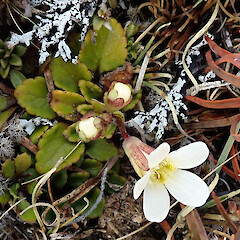Ourisia vulcanica
Common name
mountain foxglove
Synonyms
None
Family
Plantaginaceae
Flora category
Vascular – Native
Endemic taxon
Yes
Endemic genus
No
Endemic family
No
Structural class
Herbs - Dicotyledons other than Composites
NVS code
The National Vegetation Survey (NVS) Databank is a physical archive and electronic databank containing records of over 94,000 vegetation survey plots - including data from over 19,000 permanent plots. NVS maintains a standard set of species code abbreviations that correspond to standard scientific plant names from the Ngä Tipu o Aotearoa - New Zealand Plants database.
OURVUL
Chromosome number
2n = 48
Current conservation status
The conservation status of all known New Zealand vascular plant taxa at the rank of species and below were reassessed in 2017 using the New Zealand Threat Classification System (NZTCS) – more information about this can be found on the NZTCS website. This report includes a statistical summary and brief notes on changes since 2012 and replaces all previous NZTCS lists for vascular plants.
Please note, threat classifications are often suggested by authors when publications fall between NZTCS assessment periods – an interim threat classification status has not been assessed by the NZTCS panel.
- Conservation status of New Zealand indigenous vascular plants, 2017 . 2018. Peter J. de Lange, Jeremy R. Rolfe, John W. Barkla, Shannel P. Courtney, Paul D. Champion, Leon R. Perrie, Sarah M. Beadel, Kerry A. Ford, Ilse Breitwieser, Ines Schönberger, Rowan Hindmarsh-Walls, Peter B. Heenan and Kate Ladley. Department of Conservation. Source: NZTCS and licensed by DOC for reuse under the Creative Commons Attribution 4.0 International licence.
2017 | At Risk – Naturally Uncommon | Qualifiers: Sp
Previous conservation statuses
2012 | At Risk – Naturally Uncommon | Qualifiers: Sp
2009 | At Risk – Naturally Uncommon
2004 | Not Threatened
Distribution
Endemic. North Island, Central Volanic Plateau.
Habitat
Mostly alpine in shaded sites, on rocky ground, near streams, in herbfield or amongst tussock.
Detailed description
Perennial herbs 60-170 mm tall, with erect inflorescences and flat to ascending leaves; stems 2.6-5.8 mm diameter; internodes 3.6-7.3 mm long, scarcely discernible because of tight clustering of leaves, glabrous. Leaves tightly tufted at terminus of stem or in subrosettes or opposite; petiole 3.0-22.0 x 0.7-5.2 mm, sparsely to densely eglandular villous on the margins only; lamina 6.9-26.8 x 4.7-20.1 mm, narrowly to broadly ovate, apex subacute, bases cuneate, margin regularly crenate, upper surface glabrescent, hairs sparse, eglandular, on proximal margins, undersides punctate. Inflorescence racemose, 66-177 mm long, bracteate, with 1-4 flowering nodes per inflorescence, 2-3 bracts and 1-3 flowers per node and c.1-8 flowers per raceme; peduncle 0.7-2.0 mm diameter, eglandular pilose. Floral bracts 9.4-19.4 x 3.4-9.4 mm, becoming smaller toward apex, sessile, narrowly lanceolate to narrowly ovate, rarely ovate, in proximal bracts margin with a few irregular, round teeth on the distal third to half of lamina, in distal bracts margin subentire to entire, glabrous or pilose on margins only, hairs eglandular, 0.4-0.8 mm long. Flowers 12.6-15.9 x 9.2-16.6 mm; pedicel 5.9-25.4 mm long, sparsely to densely pilose, hairs up to 1.1. mm long, eglandular, rarely mixed with short, glandular hairs near calyx base. Calyx 5.6-8.6 x 5.7-8.2 mm, irregular, externally glabrous or with isolated eglandular hairs to 0.7 mm long near base only, internally glabrous, margin ciliate, with isolated to densely distributed eglandular hairs to 0.7 mm long; anterior calyx lobes 5.1-7.6 x 1.6-2.9 mm, posterior calyx lobes 2.6-4.5 x 1.4-2.4 mm, 3 posterior calyx lobes divided 1/4-1/2 of length, 2 anterior lobes divided almost to base, lanceolate to narrowly ovate, elliptic, slightly tapering to a rounded or sometimes subtruncate apex bearing a hydathode, undersides 3-veined. Corolla 11.7-15.6 x 16.4-19.9 mm when flat, bilabiate, tubular-funnelform, white, sometimes flushed red, glabrous or externally bearing isolated, eglandular hairs near base of corolla lobes; tube 5.4-9.4 x 5.3-7.6 mm at apex, 2.3-2.7 mm wide at base, not constricted near base, yellow inside with 3 lines of hairs extending to the corolla lobes and forming a ring around the corolla tube mouth; anterior corolla lobes 5.1-8.2 x 3.8-6.1 mm at widest point, 2.4-3.6 mm wide at base, posterior lobes 4.0-6.2 x 3.6-5.7 mm wide at widest point, 3.1-3.8 mm wide at base, widely spreading, obovate-spathulate, obcordate, apex plane or slightly emarginate. Stamens 4, didynamous; comprising two long stamens 8.2-11.5 mm long, exserted, or rarely only reaching tube opening, and two short stamens 6.5-9.9 mm long, reaching tube opening or exserted; anthers 0.7-1.2 x 0.8-1.4, reniform to horseshoe-shaped; staminode c.0.5 mm long inserted 0.3 mm above base of corolla, or absent, Style 6.0-7.4 mm long, straight, exserted; stigma 0.4-0.9 mm diameter, emarginate; ovary 2.5-4.0 x 1.6-2.0 mm, c.4.2 mm diameter, glabrous. Capsule 5.6 x 4.2 mm, glabrous with loculicidal dehiscence; fruiting pedicels 22.5-29.8 mm long. Seeds 0.7-0.9 x 0.3-0.5 mm.
Similar taxa
Distinguished by the small, compact, creeping or subrosette growth habit, very short internodes (often obscured by leaves), sparsely, mostly eglandular, hairy leaves, bracts, peduncles and pedicels.
Flowering
October - May
Flower colours
Red/Pink, White
Fruiting
December - May
Propagation technique
Difficult - should not be removed from the wild
Etymology
ourisia: After Ouris, governor of the Falkland Islands
vulcanica: Of volcanoes
Where To Buy
Not commercially available.
Attribution
Description based on Meudt (2006).
References and further reading
Meudt, H.M. 2006: Monograph of Ourisia (Plantaginaceae), Systematic Botany Monographs 77. 188 pp.











